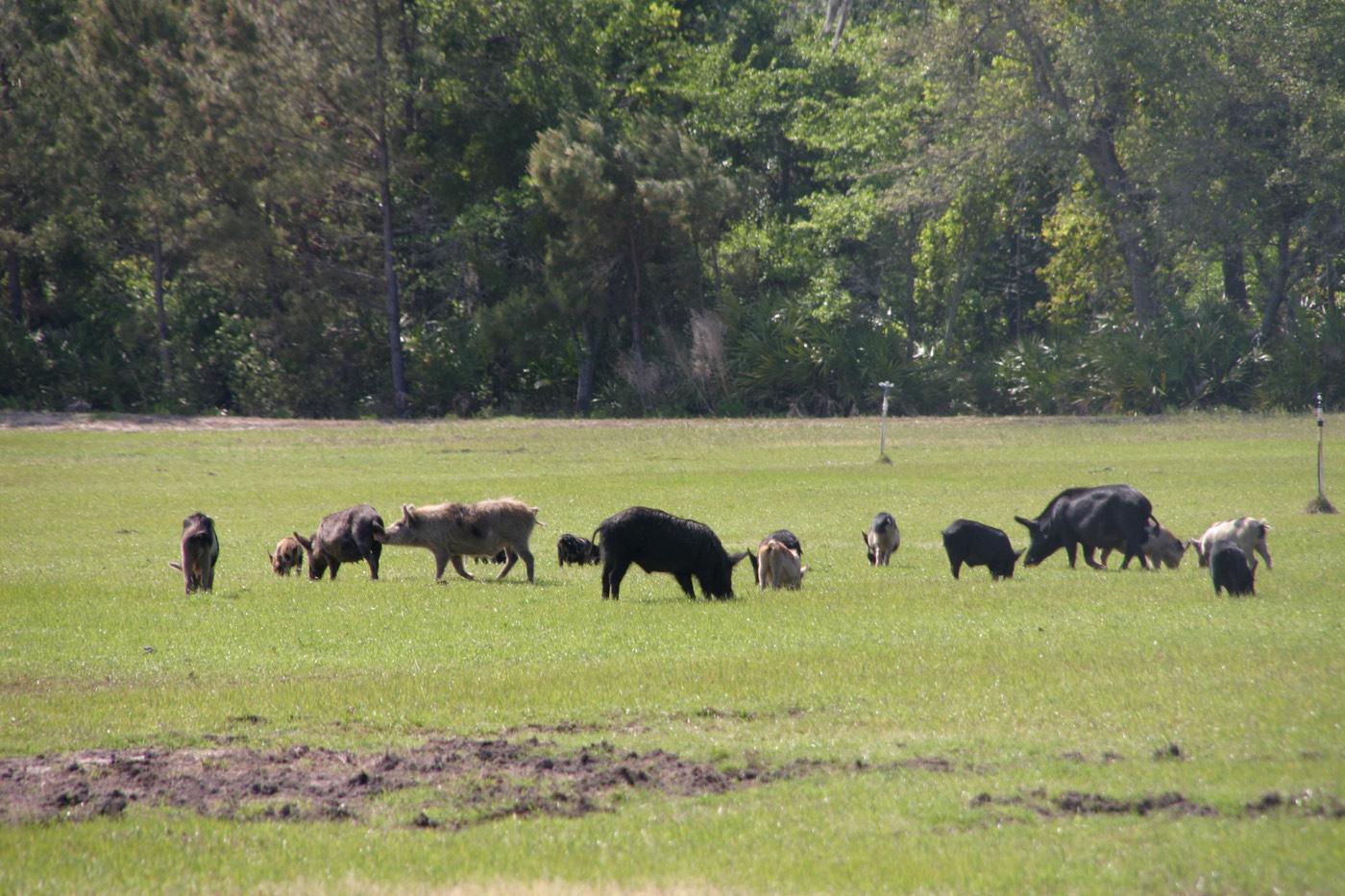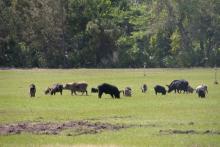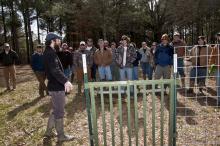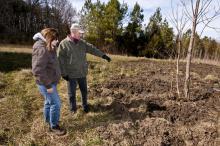Information Possibly Outdated
The information presented on this page was originally released on March 25, 2010. It may not be outdated, but please search our site for more current information. If you plan to quote or reference this information in a publication, please check with the Extension specialist or author before proceeding.
Wild pigs make tracks all over Mississippi
By Karen Templeton
MSU Ag Communications
MISSISSIPPI STATE – Wild pigs are digging up trouble across the state and causing major crop damage, so Mississippi State University and federal experts are helping landowners and farmers eradicate the troublesome beasts.
Wild pigs are a highly adaptable species that is not native to North America. They are seen throughout the country, causing vast agricultural and environmental damage.
According to the U.S. Department of Agriculture, there are about 4 million wild pigs in more than 35 states, with the largest population being in Texas. They have been seen in Mississippi since the 1980s and, today, have been spotted in almost every county, with higher concentrations in the Delta and southern parts of the state.
“Pigs are thought to have first been introduced to the United States by Hernando DeSoto during his North American explorations,” said Bronson Strickland, assistant Extension professor in the MSU Department of Wildlife, Fisheries and Aquaculture. “Today, most wild pigs seen in Mississippi are feral, from previously domesticated swine. Studies have linked some wild pigs back to feral-domestic and feral-Russian hybrids.”
Wild pigs vary in their physical appearance and are seen in any combination of colors, but are most frequently blackish in color or spotted. Their populations grow at an astronomical rate. Wild pigs reach sexual maturity in less than a year, and females can have more than one litter a year. It’s possible for their population to double in just one year, Strickland said.
“What made pigs so ideal for domestication is what makes them a problem in the wild,” Strickland said. “They are opportunistic omnivores, so they can survive on just about anything such as acorns, roots, fawns, rabbits and reptiles.”
One of wild pigs’ favorite meals has caused major problems for farmers in Mississippi.
“Wild pigs are ruining crops all over the state,” Strickland said. “They can get on a farm and root up entire crop rows in just one night. They can dig up almost every single seed in a field. They aren’t picky; they get into soybeans, corn, and most recently, peanut farms.”
Strickland said one study estimated that wild pigs are costing the United States about $1.2 billion a year in agricultural and environmental damage.
“They not only are ruining row crops, but they are also causing major environmental damage,” said Kris Godwin, Mississippi Wildlife Services Director for USDA’s Animal and Plant Health Inspection Service. “They are competing with deer and other wildlife for resources, and causing erosion in creeks.”
Paul Sellars, who owns a tree farm in Oktibbeha County, has seen firsthand the damage wild pigs can cause. His land has suffered major damage from wild pigs in the area.
“I cannot get my bush hog through the area they’ve been rooting up. I basically can’t maintain that part of my land,” Sellars said. “They multiply quickly and are completely out of control.”
Sellars depends on Godwin and her colleagues to help control the wild pig damage.
“We can remove hogs from property and will do so for free, as long as we are permitted to sample the animals for diseases,” Godwin said. “We are concerned about diseases such as pseudorabies and swine brucellosis. There have not been any confirmed cases of these diseases yet, but we need to be on alert. The spread of diseases such as these can be detrimental to livestock operations in the state.”
Godwin and her team have trapped wild pigs in much of the state.
“Our phones ring off the hook with requests for help with getting rid of wild pigs. We even removed a wild pig from downtown Gulfport,” she said. “Peanut farmers are working to make a significant comeback in Mississippi, so they’ve been diligent about letting us know of any wild pig problems. Their acreage is getting hit pretty hard.”
Strickland and Godwin both said setting traps is the recommended method for removing wild pigs from a property.
“Trapping followed by euthanasia is an effective way to reduce wild pig populations,” Godwin said. “The key to successful trapping is having the right trap door design.”
An effective door is one that activates once pigs have entered and then prevents the pigs from escaping, Godwin said.
“There are three main trap designs that we suggest using,” Strickland said. “The most frequently recommended and used trap is a cage trap that can capture a large number of pigs at once.”
To help farmers and landowners design and build successful traps, MSU Extension in partnership with USDA has been providing workshops across the state on wild pig trapping.
“The workshops have been successful so far. They give landowners a chance to get in-depth instruction and have the opportunity to ask questions,” Strickland said. “We now have a Wild Pig Mobile Education Unit, so we can show landowners and farmers physical examples of traps. We also are producing a how-to video guide.”
MSU and federal experts also are encouraging hunting wild pigs as an additional means of population control.
“Trapping needs to be the main means of getting rid of wild pigs because recreational hunting alone will not even put a dent in the population,” Strickland said. “But we do encourage people to take advantage of the opportunity to hunt wild pigs.”
Godwin said hunters need to practice proper precautions when handling wild pig carcasses.
“Gloves should be worn when handling and cleaning wild game,” she said. “Also, like with any other pork product, wild pigs need to be cooked thoroughly before eating.”
Sellars said in addition to the trapping USDA is doing on his property, he has been hunting.
“I have to use whatever means I have available to get rid of them,” he said. “They certainly aren’t going to go away on their own.”







